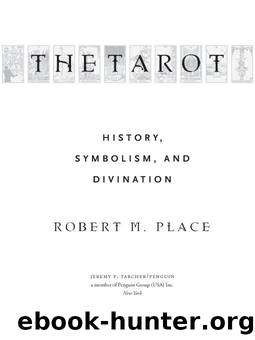The Tarot by Robert Place

Author:Robert Place
Language: eng
Format: epub
Publisher: Penguin Publishing Group
Published: 2016-04-02T11:25:58.021453+00:00
4
INTERPRETING THE MAJOR AND MINOR ARCANA
It is not of Alchemy or Kabalism or Astrology or Ceremonial Magic;
but, as I have said, it is the presentation of universal types,
and it is in the combination of these types—if anywhere—
that it presents Secret Doctrine.
—A. E. WAITE, THE PICTORIAL KEY TO THE TAROT
We are now ready to continue our interpretation of the Tarot with a deeper look at its individual images, and later we will explore methods of creating card spreads and readings. Once again, we will be going over the Tarot of Marseilles. In many respects, the Tarot of Marseilles—while not a single deck but a closely linked family of decks emerging in late sixteenth-century France—was the fullest early expression of the disparate images that came to be regarded as the Tarot. Indeed, the Marseilles deck, in its variants, can be considered the blueprint for later eighteenth- and nineteenth-century occult decks, and, therefore, it is the blueprint for the influential twentieth-century Waite-Smith deck, which we will explore in Chapter Five.
One of the first things that can be noticed about the Major Arcana in the Tarot of Marseilles is that it is composed of twenty-one cards numbered with roman numerals, called trumps, and an unnumbered Fool. While, in rare incidents, the Fool has been assigned a zero in some decks, there is no zero or a concept of zero in roman numerals; therefore, the Fool is really unnumbered. The trumps are organized in a sequence like a parade and the Fool is not part of the sequence. As we learned in Chapter Three, this parade of trumps is modeled on the Renaissance secular parade called a triumph, in which each character in the sequence is considered more powerful than the one before. This triumphal hierarchy is used in the deck to allow each card to trump the ones that come before, and the highest trump played will win the hand when playing the game. The Fool is also called the excuse. He can be played instead of a trump but he cannot win the hand.
Because the Tarot was originally designed for playing a game, the modern reader may think that it was only intended to be a trivial pastime and that it is pointless to look for a deeper meaning in the deck. In the Renaissance, however, popular art forms such as games were considered a suitable venue for meaningful symbolic statements. As we learned in the last chapter, the actual parades that the trumps were derived from were highly symbolic and expressive, and, at times, conveyed a deep mystical message. The triumph was also used as a metaphor in mystical poetic allegories, such as the influential “I Trionfi,” by the celebrated fourteenth-century poet Petrarch, and illustrations designed for “I Trionfi” were incorporated into numerous popular works of art. In turn, the mystical message expressed in “I Trionfi” influenced future triumphs and popular arts based on the triumph, such as the Tarot.
The allegory in the trumps is clearly mystical. As we look at this allegory, we can see that it is in three parts or three acts.
Download
This site does not store any files on its server. We only index and link to content provided by other sites. Please contact the content providers to delete copyright contents if any and email us, we'll remove relevant links or contents immediately.
Becoming Supernatural by Dr. Joe Dispenza(7099)
Tools of Titans by Timothy Ferriss(6934)
The Witchcraft of Salem Village by Shirley Jackson(6578)
Inner Engineering: A Yogi's Guide to Joy by Sadhguru(5887)
The Four Agreements by Don Miguel Ruiz(5502)
The Power of Now: A Guide to Spiritual Enlightenment by Eckhart Tolle(4748)
The Wisdom of Sundays by Oprah Winfrey(4623)
Room 212 by Kate Stewart(4099)
Fear by Osho(4083)
Pale Blue Dot by Carl Sagan(3995)
The David Icke Guide to the Global Conspiracy (and how to end it) by David Icke(3875)
Rising Strong by Brene Brown(3777)
Animal Frequency by Melissa Alvarez(3750)
How to Change Your Mind by Michael Pollan(3668)
Sigil Witchery by Laura Tempest Zakroff(3648)
Real Magic by Dean Radin PhD(3562)
Secrets of Antigravity Propulsion: Tesla, UFOs, and Classified Aerospace Technology by Ph.D. Paul A. Laviolette(3430)
The Art of Happiness by The Dalai Lama(3377)
Man and His Symbols by Carl Gustav Jung(3309)
